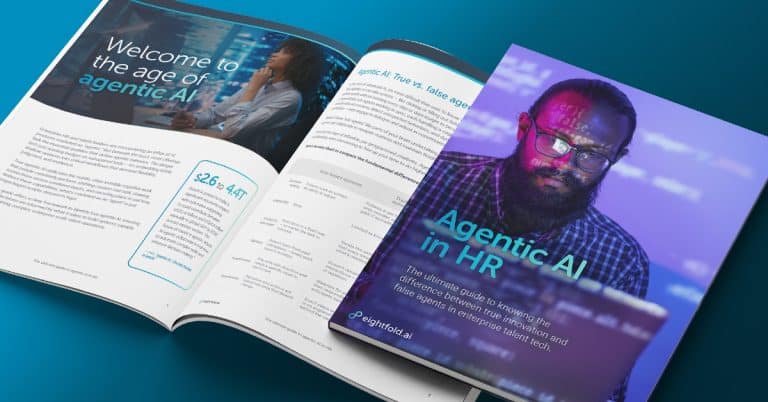
Agentic AI in HR
Agentic AI in HR
The age of agentic AI is here, but not all “agents” are equal. Beneath the buzz, the way enterprise AI solutions are built and deployed can determine whether you’re investing in true agentic AI or just buying into hype.
True agentic AI replicates the subtle, often invisible cognitive work that people constantly perform, such as shifting context mid-task, drawing connections between unrelated inputs, and rerouting plans in real time.
Without those capabilities, an “agent” is just prepackaged scripts dressed in hype — a false agent.
In this guide, you’ll learn more about this next-generation artificial intelligence, including:
- What true agentic AI is and looks like in action, including the ability for multi-step reasoning, troubleshooting in real time, and making decisions within certain contexts.
- Why agentic AI is needed now to help HR navigate an age of uncertainty and increased agility.
- How to differentiate true agentic AI from false agents.
Welcome to the age of agentic AI
Enterprise HR and talent leaders are encountering an influx of AI products marketed as “agents.” But beneath the buzz, most offerings lack the essential qualities that define agentic behavior. The danger isn’t just wasting budget on suboptimal technology — it’s embedding brittle, shallow systems into critical workflows that demand flexibility, judgment, and resilience.
True agentic AI replicates the subtle, often invisible cognitive work that people constantly perform: shifting context mid-task, drawing connections across unrelated inputs, and rerouting plans in real time. Without these capabilities, what’s marketed as an “agent” is just prepackaged scripts dressed in hype.
This guide offers a clear framework to identify true agentic AI, ensuring your decisions are informed by what it takes to build systems capable of sustaining complex, enterprise-scale talent operations.
Agentic AI: True vs. false agents
In the race of advanced AI, it’s more difficult than ever to know what is true agentic AI and what is a false agent.
True agentic AI can take action — like clicking or filling out fields — across digital spaces it understands. It can achieve goals without needing every step or data insight to be explicitly coded. It operates more like networks of specialized sub-agents working in sync, each handling a cognitive function. It can monitor for redundancies, identify ethical concerns, detect unexpected behaviors, and dynamically adjust to accommodate changing workflows — even engage in dialogue and adjust in conversations.
Think of these “sub-agents” like parts of your brain undertaking different functions to operate as a whole. These agents can collaborate to navigate nuances and maintain fluidity. Gone are the days of inflexible, pre-programmed chatbots. Agentic AI can take on more tasks like scheduling, coordinating, even interviewing to free up your time to do higher level work.
Why now is the time for agentic AI
Talent environments aren’t static — your HR tech solution shouldn’t be either.
Modern enterprise talent environments are dynamic, unpredictable, and shaped by incomplete information, ambiguous goals, and constant change. Roles shift. Skills evolve. Career paths are non-linear. Your decisions can’t always wait for perfect data.
Agentic AI is engineered to work in this dynamic environment. It has the ability to help you tame the unpredictable, see the unseen, and work toward solving HR challenges like reducing time to hire and improving candidate matching in real time. It doesn’t just automate steps or follow a pre-programmed path. Agentic AI reasons through complexity, adjusts strategies, and interprets context as it unfolds.
Most false agents rely on predefined flows and single-shot prompts. The reality is that talent work is recursive, often circling back to refine judgments, reconsider priorities, or revisit prior answers. These are all functions where agentic AI thrives.
The world of HR will continue to be more complex as AI and skills evolve. And as complexity scales, only AI that can blend automation with embedded reasoning will keep pace.
You might also like...
Get the latest talent news in your inbox every month
By submitting this form, I consent to Eightfold processing my personal data in accordance with its Privacy Notice and agree to receive marketing emails from Eightfold about its products and events. I acknowledge that I can unsubscribe or update my preferences at any time.
